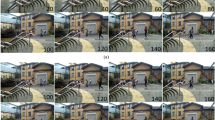Abstract
Recovery of fragmented files is an important part of digital forensics. Video files are more likely to be fragmented since their sizes are relatively large that recovering video files without the file system information is meaningful. This paper presents a video recovery technique of a fragmented video file using the frame size information in every frame and the index. Many existing video recovery techniques attempt to recover videos using file system information or header/footer flag. These approaches may fail in the situations which the file system information is unknown or videos are fragmented. The proposed method addresses how to extract AVI file fragments from data images and map all the extracted fragments into original order. Experiments result show that mapping the AVI fragments according to the frame size information in every fragment and index is credible and the non-overwritten part of the fragmented video can be recovered using the method.








Similar content being viewed by others
References
Aronson L, van den Bos J (2011) Towards an engineering approach to file carver construction. In: 2011 IEEE 35th Annual of computer software and applications conference workshops (COMPSACW), pp 368–373
AVI Format http://msdn.microsoft.com/en-us/library/windows/desktop/dd318189(v=vs.85).aspx
Billard D, Hauri R (2010) Making sense of unstructured flash-memory dumps. In: Proceedings of the 2010 ACM symposium on applied computing, SAC ’10. ACM, New York, pp 1579–1583
Carrier B (2005) File system forensic analysis, vol 3. Addison-Wesley Reading
Garfinkel S.L. (2007) Carving contiguous and fragmented files with fast object validation. Digit Investig 4:2–12
Gu B, Sheng VS (2016) A robust regularization path algorithm for ν-support vector classification. In: IEEE Transactions on neural networks and learning systems
Hu C, Xu Z, Liu Y, Mei L, Chen L, Luo X (2014) Semantic link network-based model for organizing multimedia big data. IEEE Trans Emerg Topics Comput 2(3):376–387
Memon N, Pal A (2006) Automated reassembly of file fragmented images using greedy algorithms. IEEE Trans Image Proces 15(2):385–393
Meyer DT, Bolosky WJ (2012) Study of practical deduplication. Trans Storage 7(4):14,1–14,20
Na GH, Shim KS, Moon KW, Kong S, Kim ES, Lee J (2014) Frame-based recovery of corrupted video files using video codec specifications. IEEE Trans Image Process 23(2):517–526
Pal A, Memon N (2009) The evolution of file carving. IEEE Signal Process Mag 26(2):59–71
Poisel R, Tjoa S (2011) Forensics investigations of multimedia data: A review of the state-of-the-art. In: 2011 Sixth international conference on IT security incident management and IT forensics (IMF), pp 48–61
Poisel R, Tjoa S (2013) A comprehensive literature review of file carving. In: 2013 Eighth international conference on availability, reliability and security (ARES). IEEE, pp 475–484
Poisel R, Tjoa S, Tavolato P (2011) Advanced file carving approaches for multimedia files. Journal of Wireless Mobile Networks. Ubiq Comput Depend Appl 2 (4):42–58
Richard I I I G, Roussev V, Marziale L (2007) In-place file carving. In: Advances in digital forensics III. Springer, pp 217–230
Richard I I I GG, Roussev V (2005) Scalpel: a frugal, high performance file carver. In: DFRWS
Sencar HT, Memon N. (2008) Overview of state-of-the-art in digital image forensics. Algorithms, Architect Inf Syst Secur 3:325–348
Steinebach M, Yannikos Y, Zmudzinski S, Winter C (2015) Advanced multimedia file carving. Wiley Online Library
Thing V, Chua TW, Cheong ML (2011) Design of a digital forensics evidence reconstruction system for complex and obscure fragmented file carving. In: 2011 Seventh international conference on computational intelligence and security (CIS), pp 793–797
Xu Z, Liu Y, Mei L, Hu C, Chen L (2015) Semantic based representing and organizing surveillance big data using video structural description technology. J Syst Softw 102:217–225
Zhang Z (2011) Digital rights management ecosystem and its usage controls: a survey. Int J Dig Content Technol Appl 5(3):255–272
Zhang Z (2012) Frontier and methodologies on digital rights management for multimedia social networks. Int J Digit Content Technol Appl 6(9)
Zhangjie F, Xingming S, Qi L, Lu Z, Jiangang S (2015) Achieving efficient cloud search services: multi-keyword ranked search over encrypted cloud data supporting parallel computing. IEICE Trans Commun 98(1):190–200
Author information
Authors and Affiliations
Corresponding authors
Rights and permissions
About this article
Cite this article
Yang, Y., Xu, Z., Liu, L. et al. A security carving approach for AVI video based on frame size and index. Multimed Tools Appl 76, 3293–3312 (2017). https://doi.org/10.1007/s11042-016-3716-4
Received:
Revised:
Accepted:
Published:
Issue Date:
DOI: https://doi.org/10.1007/s11042-016-3716-4




